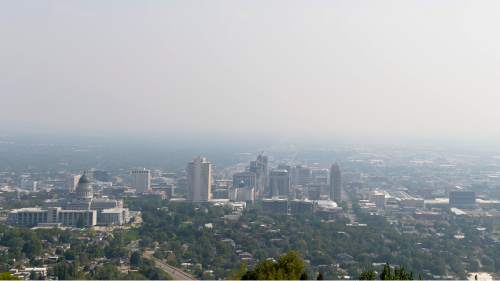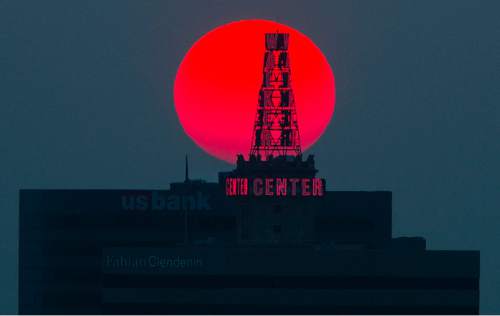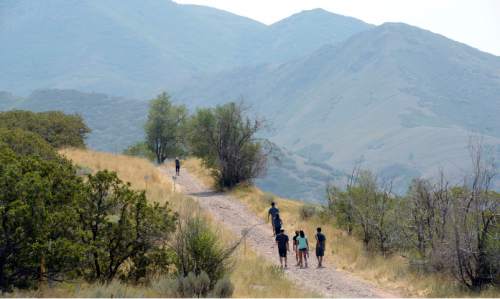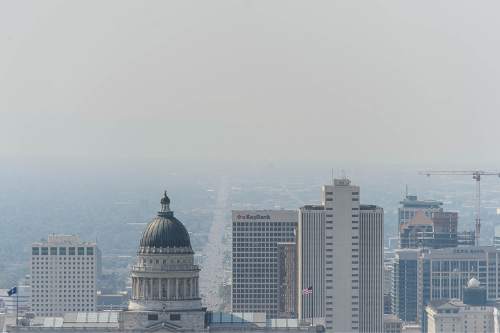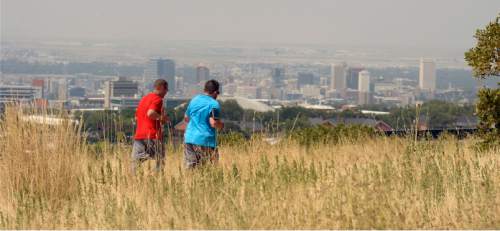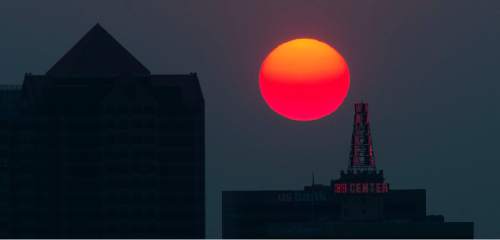This is an archived article that was published on sltrib.com in 2015, and information in the article may be outdated. It is provided only for personal research purposes and may not be reprinted.
It is a case of dangerous "secondhand smoke" writ large: Clouds of particulates billowing into Utah from massive wildfires consuming much of California and Washington have degraded air quality to near-winter inversion levels.
On Friday, the Utah Division of Air Quality declared that Salt Lake, Davis, Utah, Weber, Box Elder and Cache counties all had sunk into the "orange," or unhealthy, category for breathability, while Tooele, Washington, Duchesne and Uintah counties were rated at "yellow," or compromised. Of the counties monitored by the DAQ, only Carbon County had a "green" grade heading into this weekend.
DAQ Air Monitoring Manager Bowen Call warned that the out-of-state forest fire pall will continue at least into early next week.
"We're saying through Tuesday, but the entire West is pretty much covered with this stuff," Call said. "So we might get a localized clearing [on Tuesday], but we could easily be back into poor air quality again by the end of next week."
The populous Wasatch Front usually has its worst air days during the winter months. Then, with colder weather capping the urban valleys, automobile and industrial emissions are trapped, particulate and ozone levels rise, and residents suffer with the resulting foul air.
Summer heat also affects air quality, generating rising ozone levels that, by themselves, can worsen air quality grades, Call said. But that is not the primary concern for the days ahead.
"As far as particulate numbers go, it is looking a lot like one of our typical winter days [in the Salt Lake Valley]," he said. "But this is a different particulate mix. The dust and particles coming in from the fires is of a different chemistry, not the same as we might get with winter cold, the inversion and stagnant air that storms can clear out."
No storms are on the horizon through this weekend and into next week. The National Weather Service's forecast is for continued hot, dry weather, with temperatures ranging from the upper 80s in northern Utah to triple digits in the southern part of the state.
"It will be a bit before we see some relief," confirmed National Weather Service meteorologist Monica Traphagan. "There will be some high pressure building over the weekend, but with the prevailing winds out of the Northwest, we likely will keep having that smoke coming in."
Traphagan added, "We have no major storm systems or gusty southerly winds developing at least until we're into the midweek period. Sorry I don't have better news."
When it comes to those sensitive to poor air quality — the elderly, very young, and those with cardiac or lung ailments — unhealthy levels of particulates, whatever their origin, can be dangerous.
"If you are susceptible to particulates, this still is particulate [pollution]. If fact, you might even be more susceptible with what's coming in," Call said. "Right now, our [unhealthy air] is pretty much all due to the wildfires."
What to do? Even though the culprit this time is primarily from unwelcome smoke wafting in from outside the state, Utahns can ensure it doesn't get worse: Avoid unnecessary trips, choosing mass transit as a travel alternative; think twice about extended outdoor activity, especially for the kids, and those with heart or lung-related conditions.
Meanwhile, the tinder-dry Beehive State faces elevated risks for its own wildfires.
The National Weather Service issued a Red Flag Warning on Friday for northwest quarter of Utah, noting that gusty winds, low relative humidity (6 percent) and dry rangelands and forests made for ideal wildfire conditions. A carelessly monitored campfire, a negligently tossed cigarette, even a hot exhaust pipe on an ATV, could spark a blaze that could quickly spread.
Twitter: @remims —




